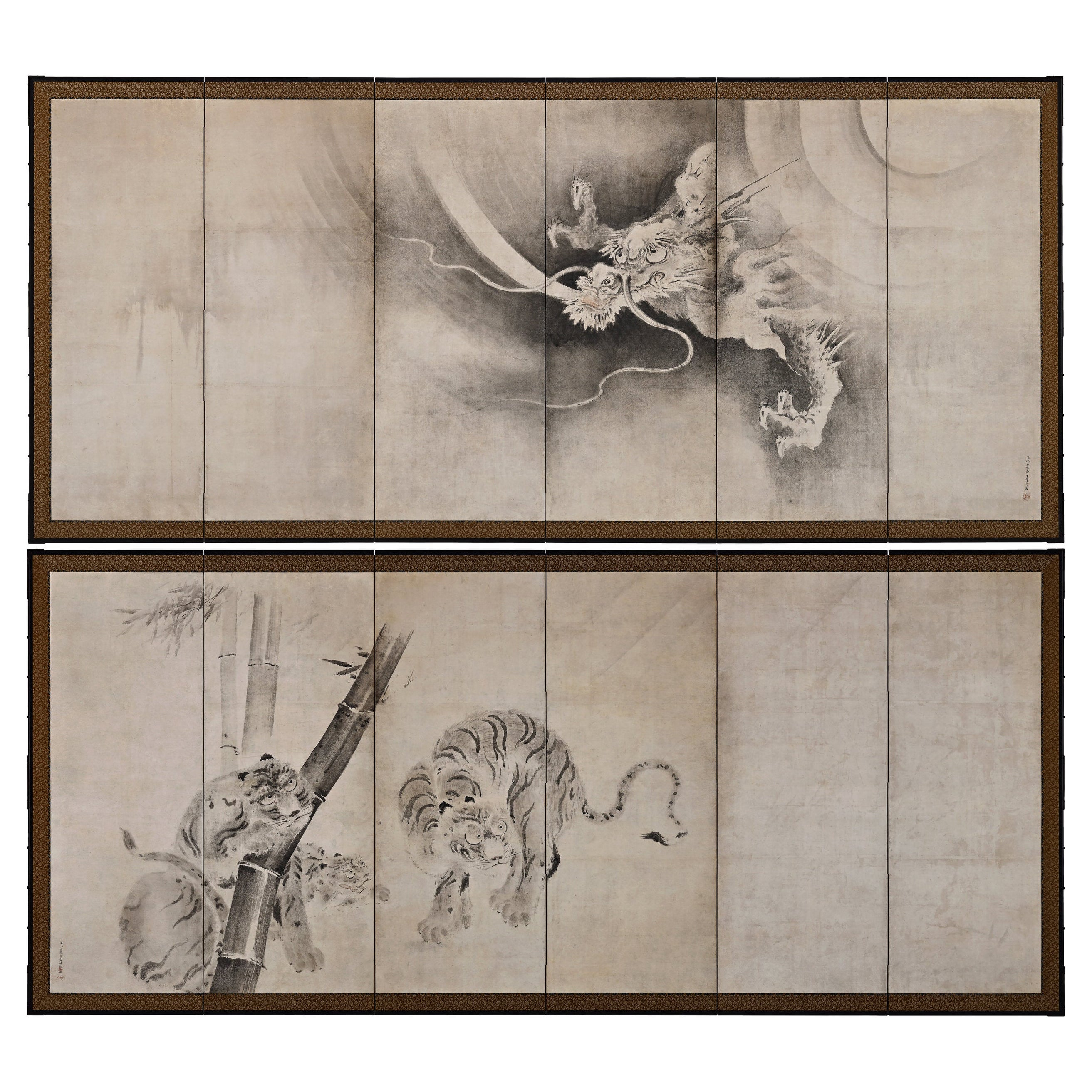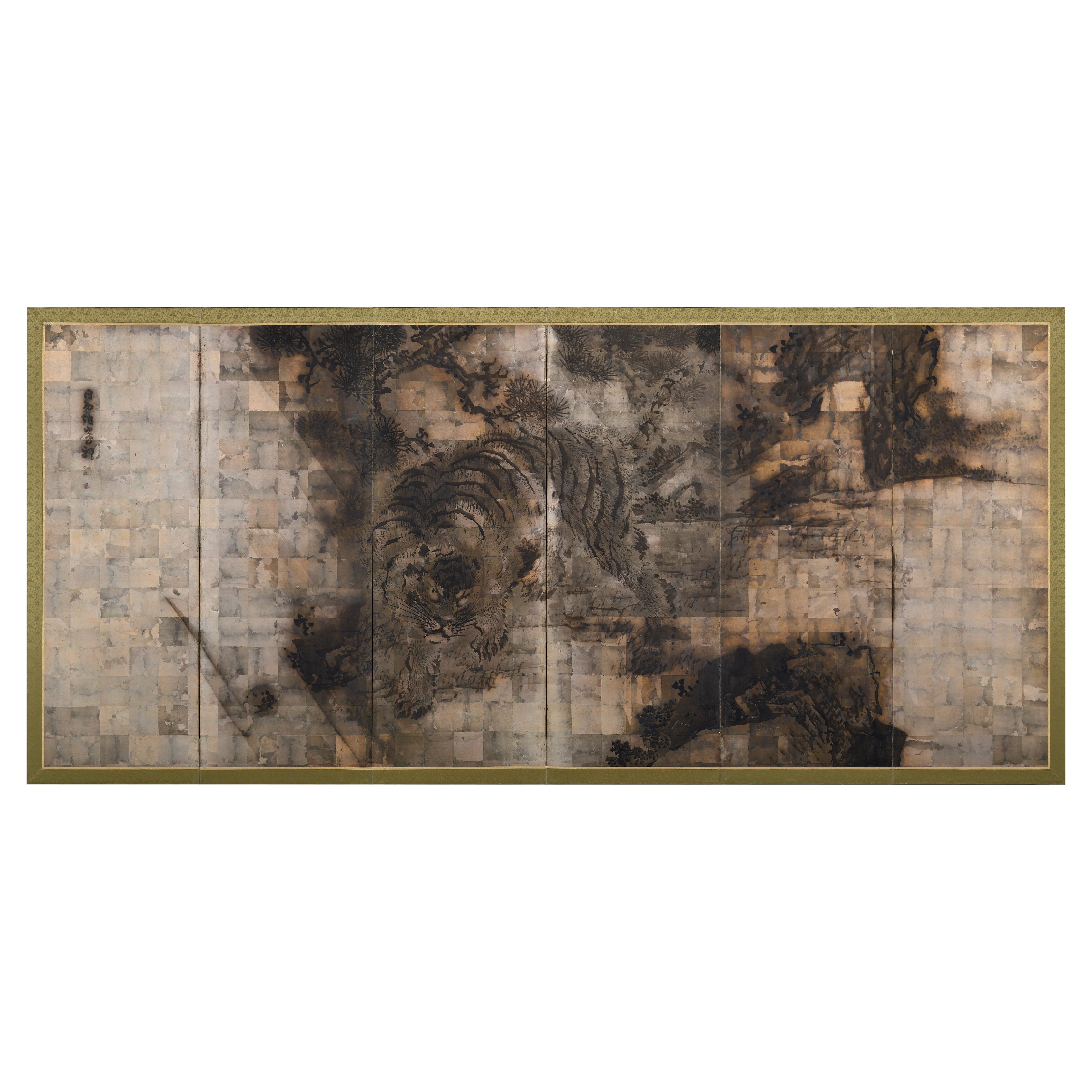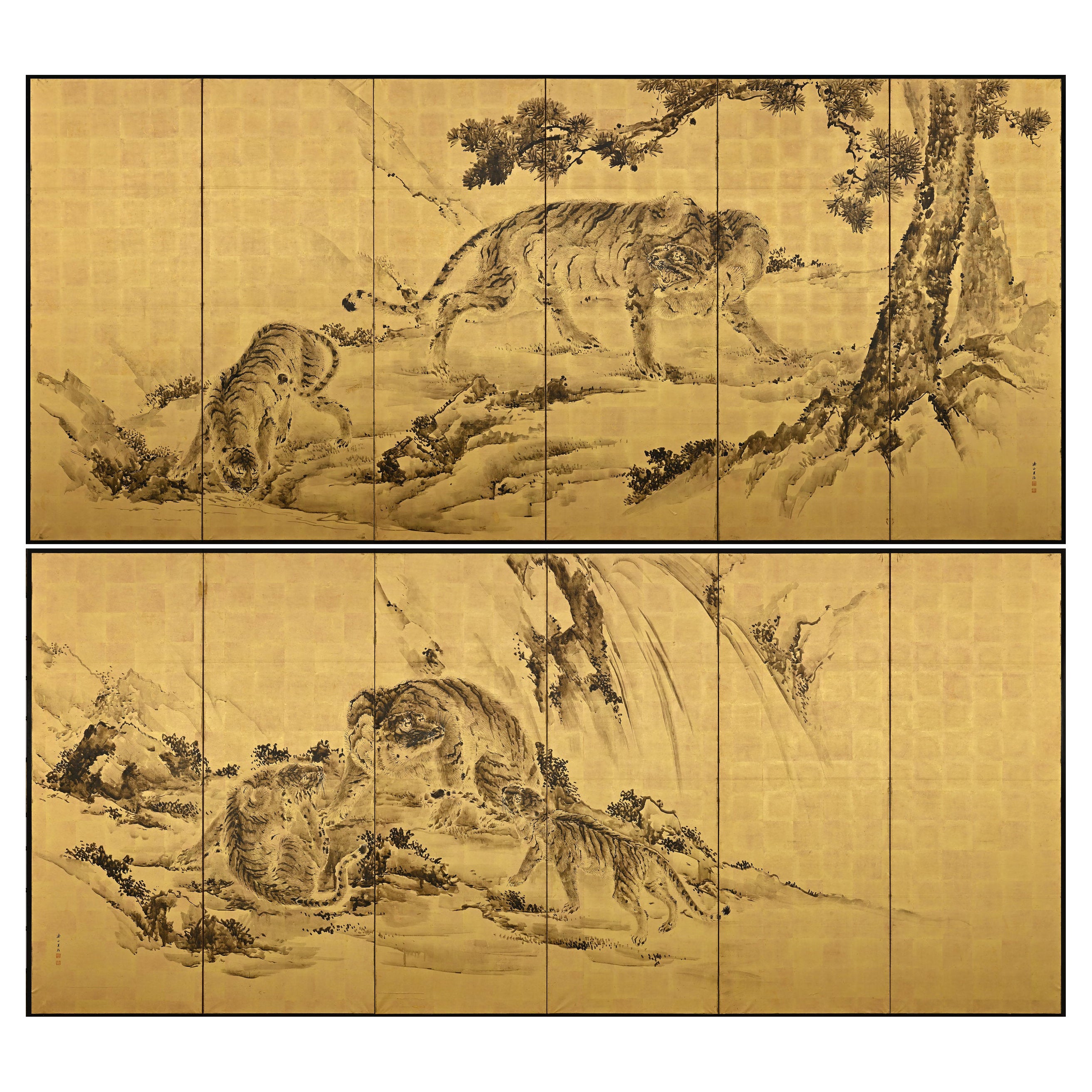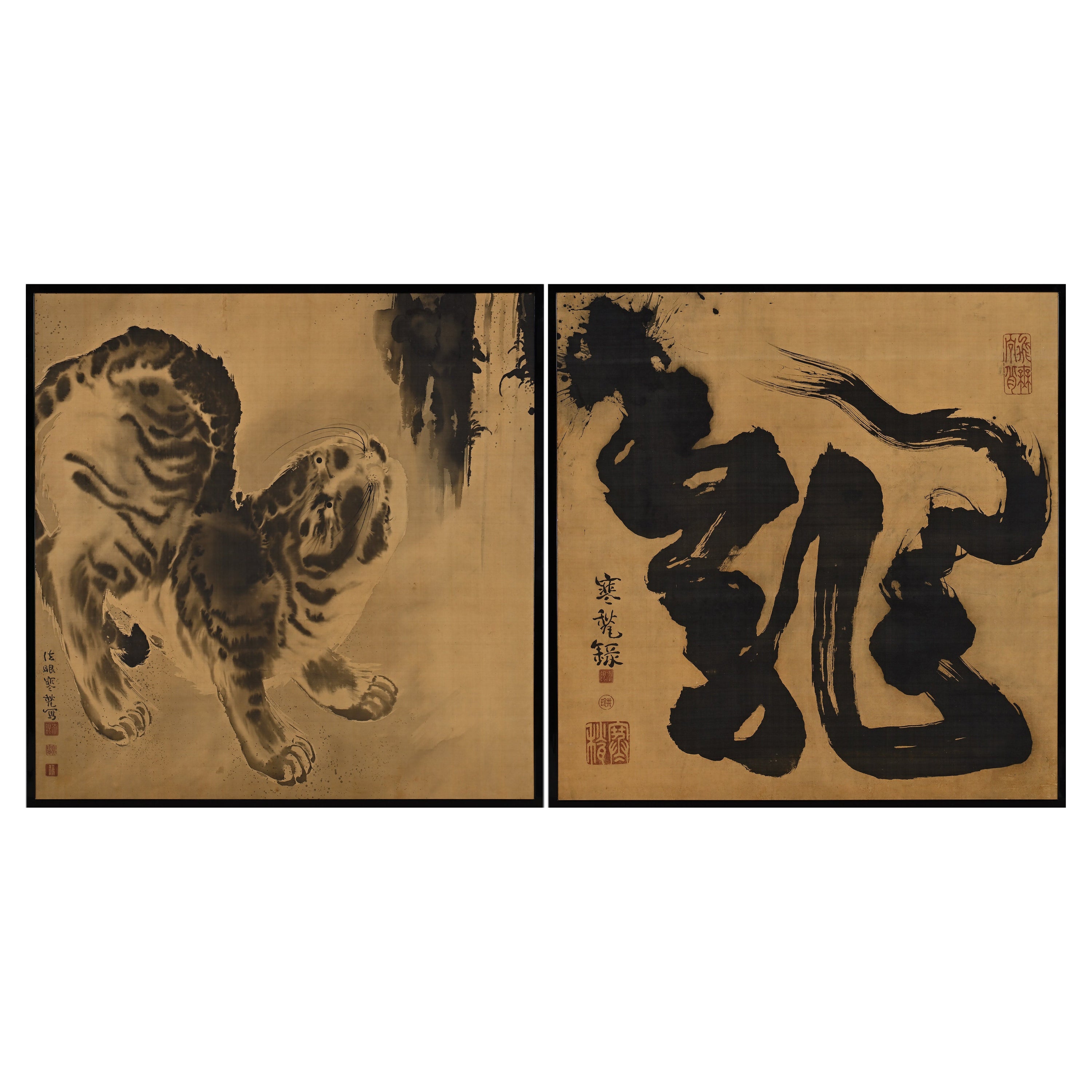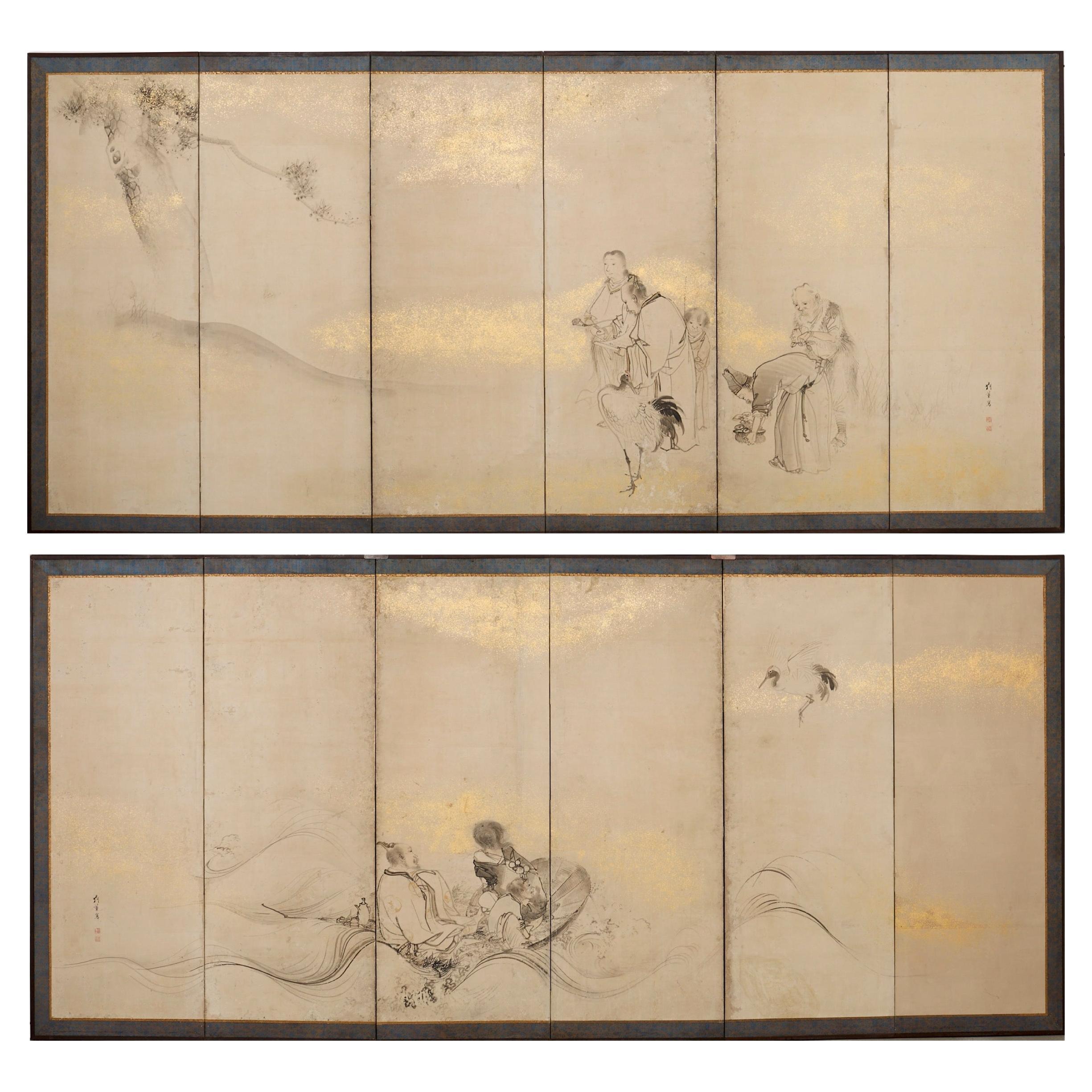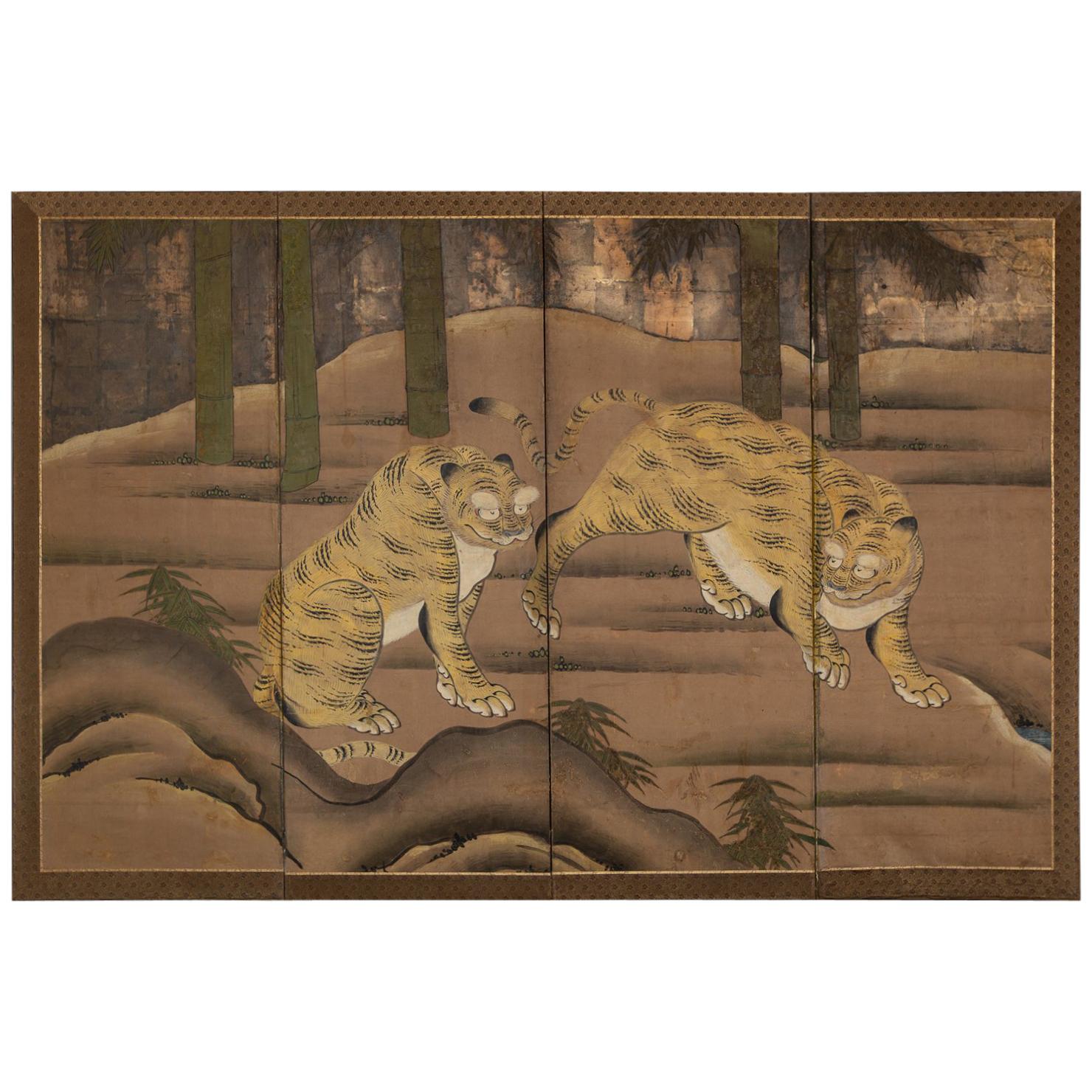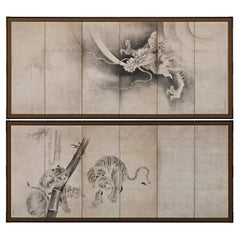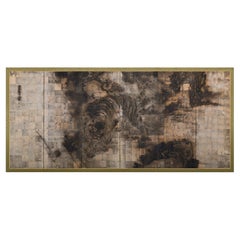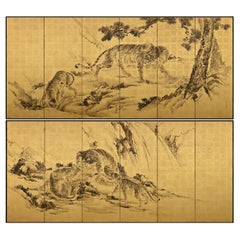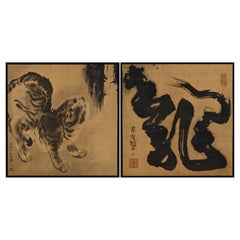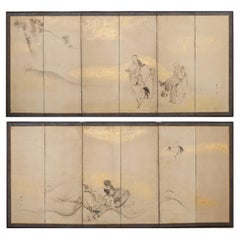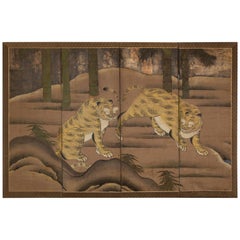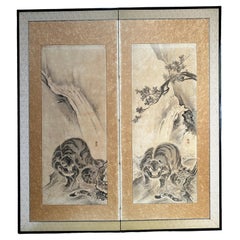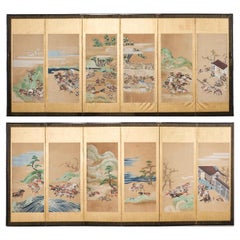Items Similar to 19th Century Japanese Screen Pair. Tiger & Dragon by Tani Bunchu.
Want more images or videos?
Request additional images or videos from the seller
1 of 11
19th Century Japanese Screen Pair. Tiger & Dragon by Tani Bunchu.
$32,000per set
£24,465.70per set
€28,179.55per set
CA$44,841.81per set
A$50,061.67per set
CHF 26,231.56per set
MX$612,803.92per set
NOK 333,141.07per set
SEK 314,109.73per set
DKK 210,306.86per set
About the Item
Tani Bunchu (1823-1876)
Tiger and Dragon
A pair of six-panel Japanese screens. Ink on paper.
In this grand pair of Japanese Ryuko-zu screens the tiger crouches low to the ground, a sign that the yin earth is the tiger’s territory. Bamboo bends in the force of the wind, said to be created by the tiger’s mighty roar. The tiger’s strength is a quiet power, held in its coiled posture. The dragon, on the other hand, is full of active energy. It emerges out of the yang heavens. Its energy causes rain clouds to swirl and whips the water below into wild waves. The tiger and dragon are ancient symbols of yin and yang, forces that combine to make up the universe.
Japan’s early artistic treatment of tigers is usually highly stylized and this example by Tani Bunchu is no exception. With no indigenous specimens to study, artists of the pre-modern period constructed their notions of the tiger from skins imported into the country. This has resulted in a rather cat-like depiction of this noble creature, capturing the essence of the animal rather than striving for realism. The Japanese dragon, like its Chinese ancestor, is an ancient mythical creature that is very different from its malevolent, treasure-hoarding Western equivalent. The Asian dragon’s origin predates written history, but had achieved its present form of a long, scaled serpentine body, small horns, long whiskers, bushy brows and clawed feet by 9th century Tang ink painting. By this time it was part of Buddhist mythology as a protector of the Buddha and Buddhist law. These traditions were adopted by the Japanese and the character for dragon is much used in temple names. In painting for the Japanese Zen sects, especially, depictions of dragons and tigers were frequently paired and appeared often on the walls and screens of monastic dwelling chambers. The motifs spread from Zen circles into the secular world and especially appealed to the military classes, tigers serving also as symbols of strength and virility.
Tani Bunchu (1823-1876) was a painter of the Tani Buncho school. He learned painting techniques from his father, Tani Bunji (1812-1850), and was an active painter in Edo and Tokyo from the end of the Edo period to the Meiji period. Tani Bunji succeeded his father Tani Buncho (1763-1840) as head of the family. Bunji passed away at the young age of 38, and there are only a few paintings left by him. Tani Buncho was a highly eclectic and influential painter working in Edo in the late 18th and early 19th centuries, who mastered a wide variety of historical painting styles from China and Japan.
- Dimensions:Height: 70.5 in (179.07 cm)Width: 144 in (365.76 cm)Depth: 0.75 in (1.91 cm)
- Sold As:Set of 2
- Style:Edo (Of the Period)
- Materials and Techniques:
- Place of Origin:
- Period:
- Date of Manufacture:Circa 1850
- Condition:Refinished. Wear consistent with age and use. This pair of screens were remounted and restored at some stage during the first half of the 20th century.
- Seller Location:Kyoto, JP
- Reference Number:1stDibs: LU2472339757662
About the Seller
5.0
Recognized Seller
These prestigious sellers are industry leaders and represent the highest echelon for item quality and design.
Established in 2001
1stDibs seller since 2016
70 sales on 1stDibs
Typical response time: 6 hours
- ShippingRetrieving quote...Shipping from: Kyoto, Japan
- Return Policy
Authenticity Guarantee
In the unlikely event there’s an issue with an item’s authenticity, contact us within 1 year for a full refund. DetailsMoney-Back Guarantee
If your item is not as described, is damaged in transit, or does not arrive, contact us within 7 days for a full refund. Details24-Hour Cancellation
You have a 24-hour grace period in which to reconsider your purchase, with no questions asked.Vetted Professional Sellers
Our world-class sellers must adhere to strict standards for service and quality, maintaining the integrity of our listings.Price-Match Guarantee
If you find that a seller listed the same item for a lower price elsewhere, we’ll match it.Trusted Global Delivery
Our best-in-class carrier network provides specialized shipping options worldwide, including custom delivery.More From This Seller
View All17th Century Japanese Screen Pair. Tiger & Dragon by Kaiho Yusetsu
Located in Kyoto, JP
Kaiho Yusetsu (1598-1677)
Tiger and Dragon
Early Edo Period, Circa 1650
A Pair of Six-fold Japanese Screens. Ink and slight color on paper.
Dimensions:
Each screen: H. 171 cm x W. 380 cm (67.5’’ x 149.5’’)
In this pair of early Edo period Japanese screens a group of tigers prowl in a bamboo grove whipped with fierce wind, while a dragon claws through clouds and mist. The dragon embodies elemental qualities - looming out of the mist, the coils of its body disappearing in the clouds. The dragon is calling for rain, symbolizing spring which is considered the fountain of life. On the other side, the tigers calls for the wind, symbolizing autumn which is considered the end of life. Tigers were familiar motifs within Japanese art from ancient times though the animals were imaginary to the people in the 17th century. While dragons and tigers are usually associated as sacred and ferocious, in this painting, both animals have rather amusing expressions. The tigers appear to glare at the dragon with cat-like eyes, and the look on the swirling dragon’s face appears almost affectionate - lending a playful flair to an otherwise magnificent theme.
The tiger and dragon are cosmological symbols of the balancing forces in the world. Screens such as this were originally meant to express the fluctuating nature of the world. For Japanese in the early Edo period, they likely suggested the powers of the cosmos. In Japan the tiger and dragon motif was originally absorbed into the circles of Zen monasteries before spreading into the secular world. The theme especially appealed to the military classes with the Kano school, the official painters to the Shogun and the samurai, being the leading contributors. The painter of this pair of screens, Kaiho Yusetsu (1598-1677), was closely patronized by the third Shogun Tokugawa Iemitsu. In his later years he worked with Kano school artists...
Category
Antique Mid-17th Century Japanese Edo Paintings and Screens
Materials
Silk, Wood, Paper
Edo period Japanese Screen. Tiger and Pine by Kishi Ganku.
Located in Kyoto, JP
Kishi Ganku (1749/1756-1838)
Tiger and Pine
A six-panel Japanese Screen. Ink on silver leaf.
The central focus of this Japanese screen is a large tiger, emerging from shadow, crou...
Category
Antique Late 18th Century Japanese Edo Paintings and Screens
Materials
Silver Leaf
Japanese Screen Pair, Tigers by Kishi Renzan, Late Edo Period
Located in Kyoto, JP
Kishi Renzan (1804-1859)
Tigers
Pair of six-panel Japanese screens.
Ink and gold-leaf on paper.
In this monochromatic pair of six-fold Japanese screens painted on gold-leaf, Kishi Renzan has created a breathtaking composition of a family of tigers. The screens are filled with a sense of drama which is conveyed by both the subject matter and the wet, expressive brushwork. The running mountain stream and the towering waterfall allude to refreshment during the summer months and we feel the tiger families familiarity and security within their environment. Renzan’s master, Kishi Ganku...
Category
Antique Mid-19th Century Asian Edo Paintings and Screens
Materials
Gold Leaf
19th Century Japanese Paintings. Zenga Tiger and Dragon by Inoue Kanshu.
Located in Kyoto, JP
Inoue Kanshu (1807-1880)
Zenga Tiger and Dragon
19th century
Pair of framed Japanese paintings. Ink on silk.
Dimensions (each): W. 114 cm x H. 115 cm (45” x 45”)
Presented here ...
Category
Antique Mid-19th Century Japanese Meiji Paintings and Screens
Materials
Silk
Circa 1900 Japanese Pine Screen Pair. Aged Dragons by Suzuki Shonen.
Located in Kyoto, JP
Suzuki Shonen (1848-1918)
Aged Dragons
A pair of six-panel Japanese screens. Ink and gold leaf on paper.
Dimensions: Each Screen: H. 170 cm x 378 cm (67" x 149")
As with the pair...
Category
Early 20th Century Japanese Meiji Paintings and Screens
Materials
Gold Leaf
17th Century Japanese Screen. View of West Lake by Unkoku Toyo.
Located in Kyoto, JP
Unkoku Toyo (1612-1668)
View of West Lake
Pair of eight-panel Japanese Screens. Ink and gold wash on paper.
Dimensions: Each screen: H. 110 cm x W. 372 cm (43” x 147”)
This pair ...
Category
Antique Mid-17th Century Japanese Edo Paintings and Screens
Materials
Paper
You May Also Like
Pair of 18th Century Japanese Edo Screens of Chinese Immortals
Located in Rio Vista, CA
Mesmerizing pair of late 18th/early 19th century Japanese Edo period byobu screens by Shibata Gito (Japanese 1780-1819). The paintings depict Chinese immortals in a dreamy landscape....
Category
Antique 18th Century Japanese Edo Paintings and Screens
Materials
Silk, Wood, Paper
Japanese Four Panel Screen: Two Tigers
Located in Hudson, NY
Two tigers exchanging amorous glances. Kano School painting.
Category
Antique 18th Century Japanese Paintings and Screens
Materials
Paper
18th Century Nagasaki School Tiger Screen
Located in Fukuoka, JP
18th Century Nagasaki School Tiger Screen
Period: Edo
Size: 165 x 172 cm (65 x 67.7 inches)
SKU: PTA69
This exceptional 18th-century screen from the Edo...
Category
Antique Early 18th Century Japanese Edo Paintings and Screens
Materials
Wood, Paper
Pair of Japanese Edo/Tokugawa Screens Tale of Heiki
Located in Rio Vista, CA
Monumental pair of late 18th century Japanese Edo/Tokugawa period byobu screens depicting the battles between Taira and Minamoto. The screens have six panels each with individual sce...
Category
Antique 19th Century Japanese Edo Paintings and Screens
Materials
Brass, Gold Leaf
Japanese Two Panel Screen Dragon in the Mist
Located in Hudson, NY
Ink (Sumi) on paper. Signature and Seal read: Kishi Ganku It is backed with paper covered in gold and silver flake. Kishi Ganku (1749 or 1756-1839) was the...
Category
Antique Early 19th Century Japanese Edo Paintings and Screens
Materials
Wood, Paper
B13 Japanese Antiques 2panels, silk, folding Screen with Tiger
Located in Niiza, JP
Material: Silk on wooden frame
One piece: W685×H1525mm×D20mm,
Unfolded size: W1370mm
Folded size: W685×H1525×D40mm, 5kg
Packaging (sandwiched with 5mm plywood): 10cm x 77cm x 160cm, ...
Category
20th Century Japanese Paintings and Screens
Materials
Silk
More Ways To Browse
Mid Century Screen
The Tiger
Japanese Dragon
Antique Japanese Dragon
Asian Tiger
Asian Tiger Art
Japanese Zen Furniture
Hand Painted Tiger
Bamboo Screen Mid Century
Japanese Wood Temple
Japanese Edo Period Screens
Chinese Wall Screens
19th Century Chinese School
Temple Japanese Buddhist
Antique Tiger Wood
Japanese Tiger
18th Century Hand Screen
Antique Tiger Wood Furniture
